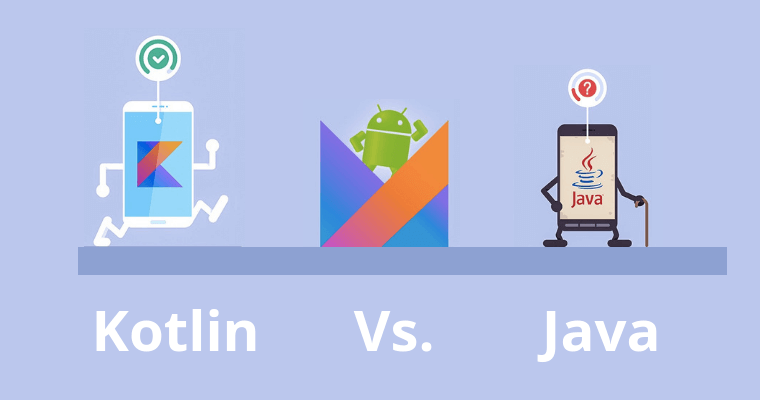Kotlin vs Java: what is better for Android development
Kotlin is a statically typed programming language developed by JetBrains. Like the Java language, Kotlin has become a great choice for developing Android applications. This can even be seen from the fact that Android Studio comes with built-in Kotlin support, as well as Java support.
Kotlin vs Java
So the
question is, is it worth the developer to switch to Kotlin with Java or not? Of
course, it depends on the preferences of the developer. However, before
switching, it is important to understand the difference between the two
programming languages.
Checked Exceptions
One of the
main differences between Java and Kotlin is that there are no conditions for
checked exceptions. Therefore, there is no need to catch or make any
exceptions.
If a Java
developer thinks using try / catch code in the code is annoying, then the
omission made by Kotlin can be considered a desired change. However, the
opposite will be if the developer believes that checked exceptions are needed,
contributing to error recovery and creating reliable code. In this case, this
can be considered a plus and minus for Kotlin, depending on the development
approach.
Code brevity
A
comparison of the Java class with the equivalent Kotlin class demonstrates the
conciseness of the Kotlin code. For the same operation that is performed in the
Java class, the Kotlin class requires less code.
For
example, a specific segment where Kotlin can significantly reduce the overall
amount of standard code is findViewByIds.
Kotlin
extensions on Android let you import a View link into an Activity file. This
makes it possible to work with this view as if it were part of an Activity.
This
clearly can be attributed to the advantages of Kotlin.
Coroutines
Processes
that intensively load the processor and network I / O usually use lengthy operations.
The calling thread is blocked until the entire operation is completed. Since
Android is single-threaded by default, the user interface of the application is
completely blocked as soon as the main thread is blocked.
The
traditional solution to this problem in Java is to create a background thread
for long or intensive work. However, managing multiple threads leads to
increased complexity, as well as errors in the code.
Kotlin also
allows you to create additional threads. However, there is a better way to
manage intensive operations in Kotlin, known as corograms or coroutines.
Kotlin’s coroutines are stack-free, which means they require less memory use
than regular threads.
Coroutines
can perform lengthy and intensive tasks, pausing execution, not blocking the
flow, and then resuming execution after some time. This allows you to create
non-blocking asynchronous code that looks like synchronous in operation.
The code
using corutine is not only clear, but also concise. Moreover, coroutines allow
you to create elegant additional styles of asynchronous non-blocking
development, such as async / await.
All this
also clearly applies to the advantages of Kotlin.
Data classes
In
full-size projects, there are usually several classes designed exclusively for
storing data. Although these classes have virtually no functionality, the
developer needs to write a lot of standard Java code.
Typically,
the developer should define a constructor and several fields for storing data,
getter and setter functions for each of the fields, as well as the equals (),
hashCode () and toString () functions.
Kotlin has
a very simple way to create such classes. It is enough for the developer to
include only the data keyword in the class definition, and that’s all – the
compiler will take care of everything.
This
convenience of creating classes, in the pros and cons for Kotlin, clearly shows
in his favor.
Extension Functions
Kotlin
allows developers to extend the class with new features using extension
functions. These functions, although available in other programming languages
such as C #, are not available in Java.
Creating an
extension function is easy in Kotlin. This is done by adding a prefix to the
class name, which should be expanded to the name of the function being created.
To call a function in instances of an extended class, you need to use the
notation “.”
Higher Order Functions and
Lambdas
A
higher-order function is a function that takes other functions as parameters or
returns a function. In addition, Kotlin functions are first class functions.
This means that they can be stored in data structures and variables that can be
passed as arguments and returned from other higher-order functions.
All this
simply means that functions can work in all possible ways in conjunction with
other non-functional values.
As a
statically typed programming language, Kotlin uses a number of functional types
to represent functions. Moreover, it comes with a set of specialized language
constructs such as lambda expressions.
Anonymous
functions and lambda expressions are also known as functional literals. These
are functions that are not declared, but are passed as expressions.
Implicit Extensible
Conversions
In Kotlin,
there is no support for implicit extending transformations for data. Thus,
smaller types cannot be converted to larger types. While Java supports implicit
conversions, Kotlin requires an explicit conversion.
A number of
developers perceive this as a minus of Kotlin.
Built-in functions
Variables
that are accessed in the function body are called closures. The use of
higher-order functions can significantly increase the computational time. Each
function in Kotlin is an object, and it captures a closure.
Both
classes and functors require memory allocation. They, along with virtual calls,
require certain costs for execution time. This extra cost can be avoided by
inserting lambda expressions into Kotlin. One such example is the lock ()
function.
Unlike
Kotlin, Java does not provide support for built-in functions. However, the Java
compiler is capable of embedding using the final method. This is because final
methods cannot be overridden by subclasses. In addition, the final method call
is resolved at compile time.
Such
innovations are also perceived as Kotlin’s advantages.
Native delegation support
In programming
terminology, Delegation is a process in which a receiving object delegates its
operations to a second delegate object. Kotlin supports the design pattern
composition on top of inheritance through first-class delegation, also known as
implicit delegation.
Kotlin
delegation is an alternative to inheritance. This mechanism allows to multiple
inheritance. In addition, Kotlin’s delegated properties prevent code
duplication.
Non-private fields
Encapsulation
is necessary in any program to achieve the desired level of controllability.
Through
encapsulation, the representation of an object can be established based on how
the callers interact with it. In addition, you can change the view without having
to change the callers if the public API remains unchanged.
Private
fields in Java are useful in scripts where callers must change according to
their presentation. This means that such fields provide an object
representation to the caller. Kotlin has no non-private fields.
This is
quite an interesting difference when comparing Kotlin and Java.
Zero security
One of the
most notable issues for Java developers is NullPointerExceptions. Java allows
developers to assign null to any variable. However, if they try to use an
object reference with a null value, a NullPointerException is shown
Unlike
Java, in Kotlin, all types are non-nullable by default. If developers try to
assign or return null in Kotlin code, a crash will occur during compilation.
However, there is a way around this point. To assign a null value to a variable
in Kotlin, you must explicitly mark this variable as nullable. This is done by
adding a question mark after the type, for example:
val number:
Int? = null
Thus, in
Kotlin there are no NullPointerException exceptions. If you encounter such an
exception in Kotlin, then most likely you have either explicitly set it to
null, or this is due to some external Java code.
Primitive types
There are 8
primitive data types, including char, double, float, and int. Unlike Kotlin,
primitive type variables are not objects in Java. This means that they are not
objects created from a class or structure.
Smart casts
Before an
object can be cast in Java, you must definitely check the type. This is also
true in scenarios where the object obviously needs to be cast.
Unlike
Java, Kotlin has a smart cast function that automatically processes such
redundant casts. You do not need to cast inside a statement if it has already
been verified by the is statement in Kotlin.
Static Members
Kotlin has
no static elements. However, in the Java programming language, the static
keyword reflects the fact that the particular member with which this keyword is
used belongs to the type itself, and not an instance of that type.
It just
means that one and only one instance of this static member is created and used
by all instances of the class.
Constructor Support
Kotlin
classes, unlike Java classes, can have one or more secondary constructors, in
addition to the primary constructor. This is done by including these secondary
constructors in the class declaration.
Ternary operator
Unlike
Kotlin, Java has a ternary operator. The ternary operator in Java acts as the
basic if. It consists of a condition that is evaluated as true or false.
In
addition, the ternary operator in Java has two meanings. Only one of them
returns depending on whether the condition is true or false. The syntax for the
Java ternary operator is:
(state) ?
(value 1): (value 2)
Wildcard Types
In common
code, ‘?’ represents an unknown type. This character is known as a wildcard.
There are several options for using a wildcard, including as a field type,
local variable, or parameter.
While the
Java type system suggests using wildcards, Kotlin doesn’t. However, it has two
other mechanisms – variability at the declaration level and type projection as
an alternative.
This will
be useful to consider when upgrading from Java to Kotlin.
Kotlin Annotation
Libraries
In addition
to providing support for existing Java frameworks and libraries, Kotlin also
offers advanced annotation-based Java frameworks.
However,
using a Java library in Kotlin that uses annotation processing requires adding
it to the Kotlin project in a slightly different way than you would for a Java
library that does not use annotation processing.
It is
required to specify the dependency using the kotlin-kapt plugin. After that,
you need to use the Kotlin annotation tool instead of annotation Processor.
Still confused? Here is the
solution – interchangeability!
Obviously,
some points are better implemented in Kotlin, while for others it is beneficial
to use Java. For those who do not want to abandon either of the two leading
programming languages for Android development, fortunately, there is another
way.
Regardless
of all the differences between the two programming languages, they are fully
compatible. Both Java and Kotlin are compiled into bytecode. This means that
there will be no definite answer to “Kotlin vs Java” questions, because you can
call Java code from Kotlin and vice versa.
This
flexibility has two advantages. Firstly, it makes it easier to get started with
Kotlin by gradually adding Kotlin code to a Java project. Secondly, both
languages can be used simultaneously in any Android application development
project.
Summary
Despite the
significant advantages of Kotlin, Java has gained the top in general-purpose
development issues. On the other hand, more developers and organizations are
introducing Kotlin to quickly develop Android applications.
Both Java
and Kotlin have advantages over each other. The discussion about which one is
better for development has just begun, and it is unlikely to end in the near
future. Questions of choice: “Why Java?”, “Why Kotlin?” Still remain. In any
case, switching from Java to Kotlin will not be hard.
Related Posts
Leave a Reply Cancel reply
Service
Categories
- DEVELOPMENT (104)
- DEVOPS (53)
- FRAMEWORKS (27)
- IT (25)
- QA (14)
- SECURITY (14)
- SOFTWARE (13)
- UI/UX (6)
- Uncategorized (8)




